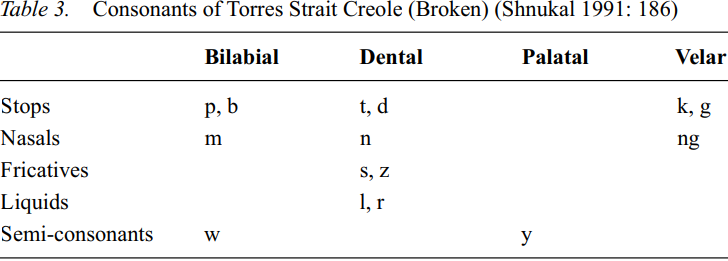
Consonants
 المؤلف:
Ian G. Malcolm
المؤلف:
Ian G. Malcolm
 المصدر:
A Handbook Of Varieties Of English Phonology
المصدر:
A Handbook Of Varieties Of English Phonology
 الجزء والصفحة:
660-37
الجزء والصفحة:
660-37
 2024-04-24
2024-04-24
 1163
1163
Consonants
Australian creoles do not always recognize the voiced-voiceless consonant distinction, nor do they reliably discriminate most fricatives. Kriol varieties may incorporate a number of retroflexed and lamino-palatal consonants not found in StE. The consonants of basilectal Fitzroy Valley Kriol have been represented (using Kriol orthography) by Hudson (1981: 28) in the following table:

Torres Strait Creole (Broken) has 15 consonant phonemes, represented in Broken orthography by Shnukal as follows:

It is common for stops to substitute for fricatives and affricates. Fraser (1977) reports that in Fitzroy Crossing Children’s Pidgin the bilabial stop /p/ substitutes for /b/, /v/ and /f/ and that a dental /t/ substitutes for /ʧ/ , /ʤ/ and non-final /s/, /z/ and /Ʒ/. Similar substitutions occur in Ngukurr-Bamyili Kriol (Sandefur 1979: 37).
Although voiced and unvoiced stops both occur in Torres Strait Creole, their distribution may not be the same as in StE. Crowley and Rigsby (1979) note the replacement of a voiceless stop with a voiced one when it occurs between two vowels, as in /peba/ for ‘paper’. There is no phonemic opposition in Torres Strait Creole between [p] and [f], between [t] and [θ], between [d] and [ð] or between [b] and [v].
In Fitzroy Crossing Kriol, /d/ may alternate with /t/. Also, Sandefur (1979: 37) observes that in Kriol, /d/ may be replaced by a flapped rhotic [ř] when it occurs in a word between two vowels.
It will be observed from Table 2 that the sound represented in Kriol orthography as <th> is not the interdental fricative of StE but an interdental stop. Similarly, the retroflexed <rt> and the lamino-palatal <tj> function as stops (Hudson 1981: 28).
All the nasal consonants of StE, /m/, /n/ and /ŋ/ also occur in Australian creoles. There are, however, in basilectal Kriol additional retroflexed and palatalized nasals.
Fricatives are generally absent from basilectal Kriol though in basilectal Fitzroy valley Kriol, there is one fricative, /s/. Fricatives are reduced in occurrence in Torres Strait Creole. There is no phonemic opposition in Torres Strait Creole between [s] and [ʃ] (Crowley and Rigsby 1979; Dutton 1970). In Kriol, sibilants tend to be deleted to avoid consonant clusters (Sharpe and Sandefur 1976); in Bamyili (Barunga) the affricates /ʧ/ and /ʤ/ are replaced by a lamino-palatal stop /dj/ (Sandefur 1979: 37). The glottal fricative /h/ is generally absent from the creoles.
The lateral /l/ is common to English and most Aboriginal languages and is retained in the creoles. Basilectal Kriol also has retroflexed and palatalized laterals.
The rhotic /r/ is trilled in basilectal Kriol and Torres Strait Creole. It may also be flapped when it occurs between two vowels (Sandefur 1979: 37).
 الاكثر قراءة في Phonology
الاكثر قراءة في Phonology
 اخر الاخبار
اخر الاخبار
اخبار العتبة العباسية المقدسة


